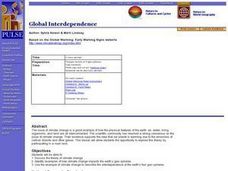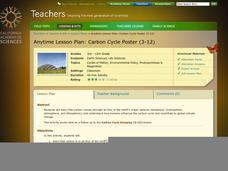Curated OER
Connect the Spheres: Earth Systems Interactions
Is everything really connected? Take your class on a walk outside, where they will make observations and write them down on a worksheet. Once they are back in the classroom, learners will work to determine if and how things like birds,...
Curated OER
We All Scream for Ice Scream
High schoolers explore the formulas for volume of three-dimensional objects. They participate in various activities involving ice cream, ice cream cones, small candies, and gum balls, recording their calculations on a lab sheet.
Curated OER
Learning About Volume
Learners explore the concept of volume. They develop formulas for volume of prisms. Then use their formulas to find missing dimensions of various prisms such as height, length, width, radius, and diameter.
Curated OER
Volume of a Snow Cone
Learners find the volume of a snow cone. They divide the snow cone into known sections, and find the are of each part. Pupils must read the scale on the snow cone, prior to plugging into the formula for its volume.
Curated OER
Why are Bubbles Spheres
Learners calculate the surface area of different polygons. In this geometry lesson, students practice calculating the volume of spheres. They work with cones, cylinders and rectangular prisms.
Curated OER
World Geography: Global Interdependence
Learners are able to discuss the theory of climate change. They identify examples of how climate change impacts the earth's geo-spheres. Students are able to use the example of climate change to describe the interdependence of the...
Curated OER
Volume Worksheet I
In this volume worksheet, students recognize three-dimensional figures, identify the proper volume formula, and then solve the equation by inserting information from a diagram into the formula. Students solve six equations.
California Academy of Science
Carbon Cycle Poster
Humans can have a big impact on the environment, specifically the influence they have on the carbon cycle. First, the class will define and discuss each of the earths four major spheres, the biosphere, hydrosphere, atmosphere, and...
Curated OER
Mapping the Mediasphere
Learners compare/contrast the media messages they see in two different communities in their city. They list the elements of art and the principles of design in the photographs they have taken in those two different communities. They...
Illustrative Mathematics
Tilt of Earth's Axis and the Four Seasons
Geometry meets earth science as high schoolers investigate the cause and features of the four seasons. The effects of Earth's axis tilt features prominently, along with both the rotation of the earth about the axis and its orbit about...
Curated OER
Bubbles
Students observe the characteristics of bubbles. For this scientific inquiry lesson, students use a bubble solution and a wand to make bubbles and observe their characteristics. Students identify the shape and the color of the bubbles.
National Center for Case Study Teaching in Science
Mask of the Black God
Finally, an astronomy lesson for the high schooler! Explorers are able to read star maps for finding objects in the night sky by determining celestial coordinates. In particular, they locate the Pleiades and read about a Navajo legend...
Curated OER
Global Positioning System I
Geometry learners touch the surface of how a global positioning system works. The end goal is to find the intersections of three different spheres geometrically and algebraically given their algebraic representations.
Curated OER
Air Resistance and Friction
Physics learners experiment with three laboratory activities to learn about air resistance and friction. First, they use a hair dryer to move different sized spheres to determine the relationship between cross-sectional area and air...
American Chemical Society
Surface Tension
A drop of dew holds a sphere shape even when sitting on a seat thanks to the surface tension of water. Learners observe the phenomena of surface tension in water. Through demonstrations, hands-on activities, and discussions they explore...
National Nanotechnology Infrastructure Network
Lab 1: Nanocatalysts Clean Your Car Emissions
What a big job for such a small particle. Young scientists learn about the role of nanoparticles in catalytic converters for cars. They conduct an experiment to create alginate-MnO2 catalytic spheres.
Curated OER
The Flat Earth
Students differentiate between different planes. In this geometry lesson, students differentiate between a plane and a sphere. They discuss the Great Circle, Geodesic and Lune as it relates to the earth.
Curated OER
World Geography: Climate Change Round Table
Students are able to explain the suspected causes of relatively recent climate changes, specifically the observed global warming. They discuss how unusual or extreme global warming disrupts the balance of the earth's geo-spheres.
Curated OER
Solid Figures Sort
First graders use Kidspiration to sort solid figures by the number of faces. They work in pairs with a set of solid figures. Students sort them according to the number of faces, or whether or not it can roll, slide, be stacked. Students...
Curated OER
Nets, Surface Area and Volume
Students calculate the surface area and volume of a sphere. In this geometry lesson, students define nets, surface areas and volume of prisms, pyramids, cylinders and cones. They use the computer to create nets and analyze shapes.
California Academy of Science
Carbon Cycle Role Play
Anytime you make concepts clear with role playing or hands-on experience, it's a win for the whole class. Ping-Pong balls are used to represent carbon in a carbon cycle role-play activity. In small groups, children first discuss what...
National Gallery of Canada
Self-Portrait, Mirrors and Metamorphosis!
Using M.C. Escher's Hand with Reflecting Sphere as inspiration, learners create their own set of self-portraits using various reflective surfaces. The instructional activity begins with a discussion about portraiture and ends with a...
EngageNY
The Binomial Theorem
Investigate patterns in the binomial theorem. Pupils begin by reviewing the coefficients from Pascal's triangle. They look at the individual terms, the sums of the coefficients on a row, and the alternating sum of each row. Individuals...
Curated OER
Draw 3 Dimensional Objects
Bring three-dimensional shapes to life in your classroom. First introduce the vocabulary of three-dimensional shapes, such as sphere, cube, and pyramid. Then, show your kids examples of how to use two-dimensional objects draw...
Other popular searches
- Cylinders Cones Spheres
- Spheres of the Earth
- Cones and Spheres
- Earth Spheres
- Volume of Spheres
- 3 Dimensional Spheres
- Four Spheres of Earth
- Spheres of Earth
- Earths Spheres
- Spheres of Earth Activity
- Earth's Spheres
- Geo Spheres

























